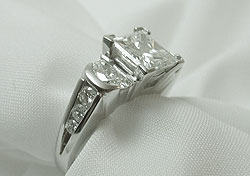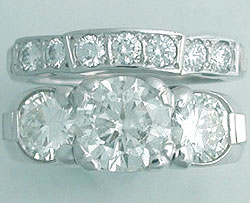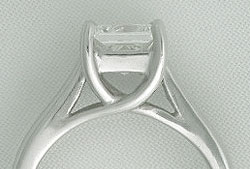  |
||||||||||||||||||||||||||||||||
| Education
Click on any of the links below to take you to additional information about the subject listed. Please don't hesitate to call or drop us a note if you have any more questions.
Platinum is one of the rarest metals on earth: it comprises only 45 parts per billion of the earth’s crust, and is found in only a few places in the world. Two mines in South Africa provide about 75% of the world’s supply. Its total production is only 6% of that of gold. On the average, 10 tons of ore need to be mined to yield just one ounce of platinum (as opposed to 3 tons per ounce for gold). All the platinum ever mined would fit into an average-sized dining room.
It’s the strongest precious metal: because of the type and arrangement of its atoms, it’s much denser than gold. When its surface is scratched or nicked, there is little or no metal lost as there is with gold. This is why jewelry with engraved or textured finishes will last indefinitely. We set most of our prong set diamonds and colored gems in platinum because of its superior strength and durability, very important when the only things holding your gemstone are those small prong tips! Bottom line: it wears longer and needs less maintenance over the years. It's heavy: Platinum is 60% heavier than 14K gold, due to those densely packed heavy atoms. This is a difference you can feel. A six inch cube weighs as much as a grown man (about 170 lbs)! It's versatile: Platinum with its pure white luster has a subtle beauty and understated elegance. And it works well in designs with 18K yellow gold, giving jewelry a sophisticated look. IS PLATINUM THE SAME AS WHITE GOLD?
Because of its extremely high melting point and superior hardness, working with platinum can pose problems for the jeweler who is not used to working with it. This can result in contamination of the metal, improper soldering, and poor polish. At Refined Designs we have taken classes with the experts in the field and have invested in the equipment needed to properly work with platinum. Make sure you bring your platinum jewelry to someone experienced in working with it. Just as with gold, pay special attention to the craftsmanship, durability, and beauty of the design. |
||||||||||||||||||||||||||||||||
© 2008 - Refined Designs Original Fine Jewelry | All rights reserved | 518-765-3750 |
||||||||||||||||||||||||||||||||
 Five
hundred years ago platinum got no respect! Spanish conquistadors in
Latin America could easily melt down artifacts made of gold and silver
in order to transport them back home, but platinum’s extremely high
melting point (1755o C.) made that impossible. It was called “platina”
meaning “lesser silver” and was usually either discarded or used in
place of lead as gunshot! Amazingly, it was almost 3,000 years ago
that Egyptians were the first to use this precious metal, although
in a limited capacity. It wasn’t until the mid-1800’s when the oxy-hydrogen
torch was developed that platinum became a viable jewelry metal.
Five
hundred years ago platinum got no respect! Spanish conquistadors in
Latin America could easily melt down artifacts made of gold and silver
in order to transport them back home, but platinum’s extremely high
melting point (1755o C.) made that impossible. It was called “platina”
meaning “lesser silver” and was usually either discarded or used in
place of lead as gunshot! Amazingly, it was almost 3,000 years ago
that Egyptians were the first to use this precious metal, although
in a limited capacity. It wasn’t until the mid-1800’s when the oxy-hydrogen
torch was developed that platinum became a viable jewelry metal. PLATINUM
HAS MANY FINE QUALITIES
PLATINUM
HAS MANY FINE QUALITIES WHAT
TO LOOK FOR
WHAT
TO LOOK FOR